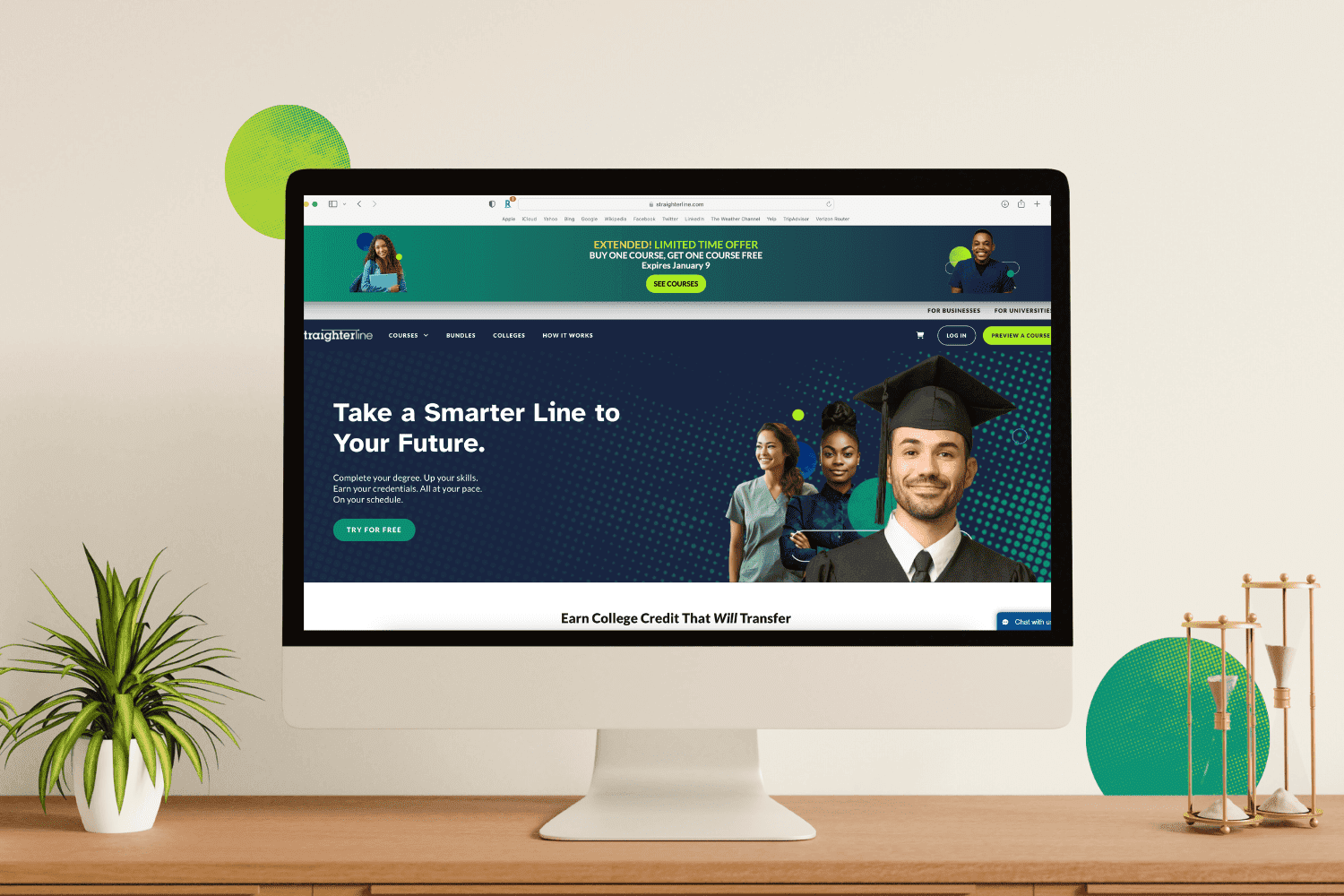The shift toward online learning, accelerated by the global pandemic and technological advancements, is undeniable. This transformation has established online education as a mainstream and legitimate alternative to traditional in-person classes.
Let’s take a look at what online learning is and how it works. We’ll also cover the primary factors that might influence whether you choose to take in-person classes or online classes, including the benefits and drawbacks of both styles.
What Is Online Learning?
Online learning is a method of education delivered through digital platforms, allowing you to access courses and interact with instructors from anywhere with an internet connection. There are both online-only learning platforms like StraighterLine as well as online classes taught through many traditional community colleges and 4-year institutions.
The Prevalence Of Online Learning
The prevalence of online learning has surged in recent years, propelled by a combination of the global pandemic and technological advancements, particularly in video conferencing. With restrictions on physical mobility during the pandemic, people turned to online platforms for education.
This means that online learning has quickly become just as popular and “legitimate” as in-person classes, especially for adults looking to complete a degree or pursue a new career path. As of 2020, almost 15% of students in higher education were enrolled in online courses, with about 60% of students taking at least some online classes as of 2021.
In-Person vs. Online Learning: A Complete Comparison
While in-person and online learning both offer quality educational experiences for students, there are some important differences to consider. Keep in mind that much will depend on your personal learning style, schedule, and general preferences.
Flexibility
The absence of physical classroom constraints with online learning benefits those with busy schedules, such as working professionals, active duty members of the military, parents, or students going through significant life changes. For example, StraighterLine’s courses allow students to organize their studies according to personal scheduling preferences.
Traditional schools only offer certain classes at certain times. If you have a scheduling conflict due to work or family obligations or because you’re taking another class, you may have to miss out on a required course.
However, some students need a stricter schedule to stay motivated. In-person classes offer the benefit of creating structure due to your physical presence being required. This in-person element requires you to make more time for your classes and creates a clear schedule that is helpful for some students.
Time
Thanks to the lack of a commute to and from school, including parking hassles and moving between classes, online classes can save learners a significant amount of time in their day. Additionally, online classes are rarely canceled due to weather issues like snow or heavy rains and flooding.
Affordability
When it comes to cost, online learning is often more affordable than attending an in-person institution. Beyond the cost of tuition, traditional schools can be more expensive in terms of books, room and board, and the price of commuting (including gas and parking).
With online learning, not only do you save money by not having to pay to live and eat on campus or commute back and forth, but the tuition itself is usually more affordable. For example, the average cost of a credit hour (across all types of colleges and universities) is around $470. That means the average student is spending about $1,400 for a standard, 3-credit college course. By taking courses online, students can save a lot of money.
At StraighterLine, for example, students can save almost $1,000 per course by taking it through our online platform and then transferring their credits to their college or university. You can use our college costs savings calculator to see how much you could save with StraighterLine.
Whether you take online courses to fulfill a variety of requirements or for a class here or there to supplement your in-person education, they can be a great option to help you keep more of your money in your pocket.
A Global Classroom Experience
Online learning allows you to virtually meet classmates from all over the world. As you learn, you’ll expand your networking opportunities and gain fresh perspectives on the subjects you study. Online learning also allows you to take classes from all around the world, exposing you to curricula you might not otherwise be able to access.
Even if the class you want or need to take isn’t necessarily considered unusual, online learning gives you access to courses that your current college may not offer. This means you have the opportunity to take an almost infinite amount of courses that interest you without leaving home!
When it comes to traditional schools, they don’t always offer the class you need (or want) to take. For example, if you have a specific major in mind or need a particular course for work, you may not find it in person.
Quality of Education
Thanks to many of the technical advancements mentioned earlier, you can often receive the same quality education online that you would in person — but on your own time and more affordably. Many well-respected institutions now offer online classes, including Harvard and Cornell.
Many online-only platforms, including StraighterLine, offer the standard courses required for general education requirements at traditional schools, with credits that can easily be transferred. This makes it easy for students, even those already at traditional schools, to fulfill gen ed credits or retake classes.
Peer Interaction
With video classes, online chats, message boards, and social media at your fingertips, online learning doesn’t have to be a solitary experience. Depending on your platform, there may be student message boards or forums, live chats, social media groups, or online study groups that help you connect with your peers along your learning journey.
For adults looking to move up in their careers or change fields entirely, this offers the chance to meet and network with peers you can then connect with on LinkedIn, potentially helping you get where you want to go.
One thing to note, though, is that despite online tools, there’s no substitute for real-time interaction with your classmates face to face. Socializing online is great, but it can’t take the place of being with your classmates in person while you learn together. It’s not uncommon for students to break out into spontaneous study groups after class, meet up in the library, or just take time to chat with their instructor. These are things that really can’t be replicated online.
Use of Technology
A potential downside of online learning is that it’s entirely dependent on your ability to access reliable, high-speed internet and use a good computer that can handle video streaming and downloads quickly. Should something go wrong — your computer crashes or you lose WiFi — you’ll be unable to access your class until everything is up and running again.
This is where in-person classes have more of an advantage. While a lot of them usually require some sort of technological component too — a laptop to complete assignments, internet access for research, the ability to navigate your school’s class pages — it's not nearly the same level of dependence. You can always go to your library (at your school or in your town) to use computers and the internet if you lack access at home.
Engagement
No matter how engaged you might be online, in-person classes are just better for deeper, more dynamic class discussions. Everyone is right there, face to face, and better able to “jump in” and speak up. There are no freezing videos, no lag time while you type your response, and no quickly-moving chat to follow.
Classrooms are also set up solely for learning, making it easier to focus on the instructor. You’re less likely to be distracted by family or other home obligations and chores.
Which Is Better: Online School Or In-Person?
When it comes to choosing between online and in-person courses, the question shouldn’t necessarily be, “Which one is better?” but rather, “Which one is right for you?” It all depends on your needs and learning preferences. As you look to start your learning journey, consider the factors listed above and decide what option will be the best fit for your schedule, needs, and goals.
Start Learning Online Today!
StraighterLine has been a trusted and reliable online learning platform since 2008. We offer students many benefits, including a large selection of affordable classes, flexibility, and 24/7 student support so that you can make the most of your online educational journey.
Try one of StraighterLine’s 70+ courses and see for yourself how successful online learning can be!












